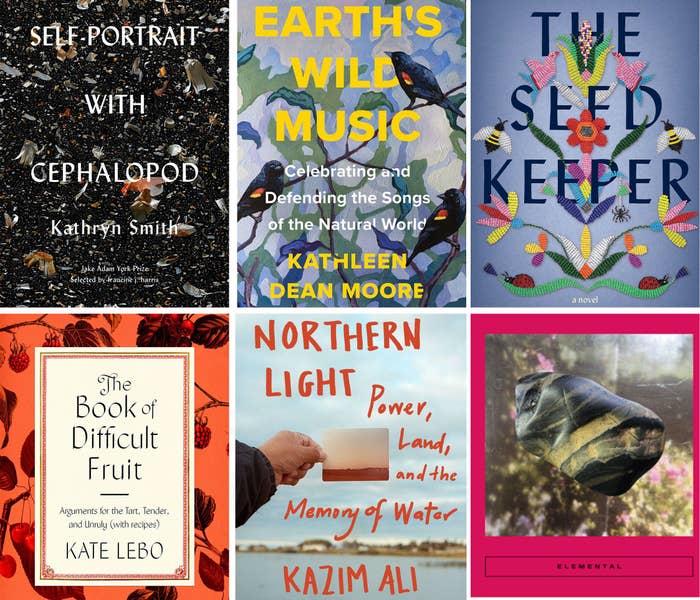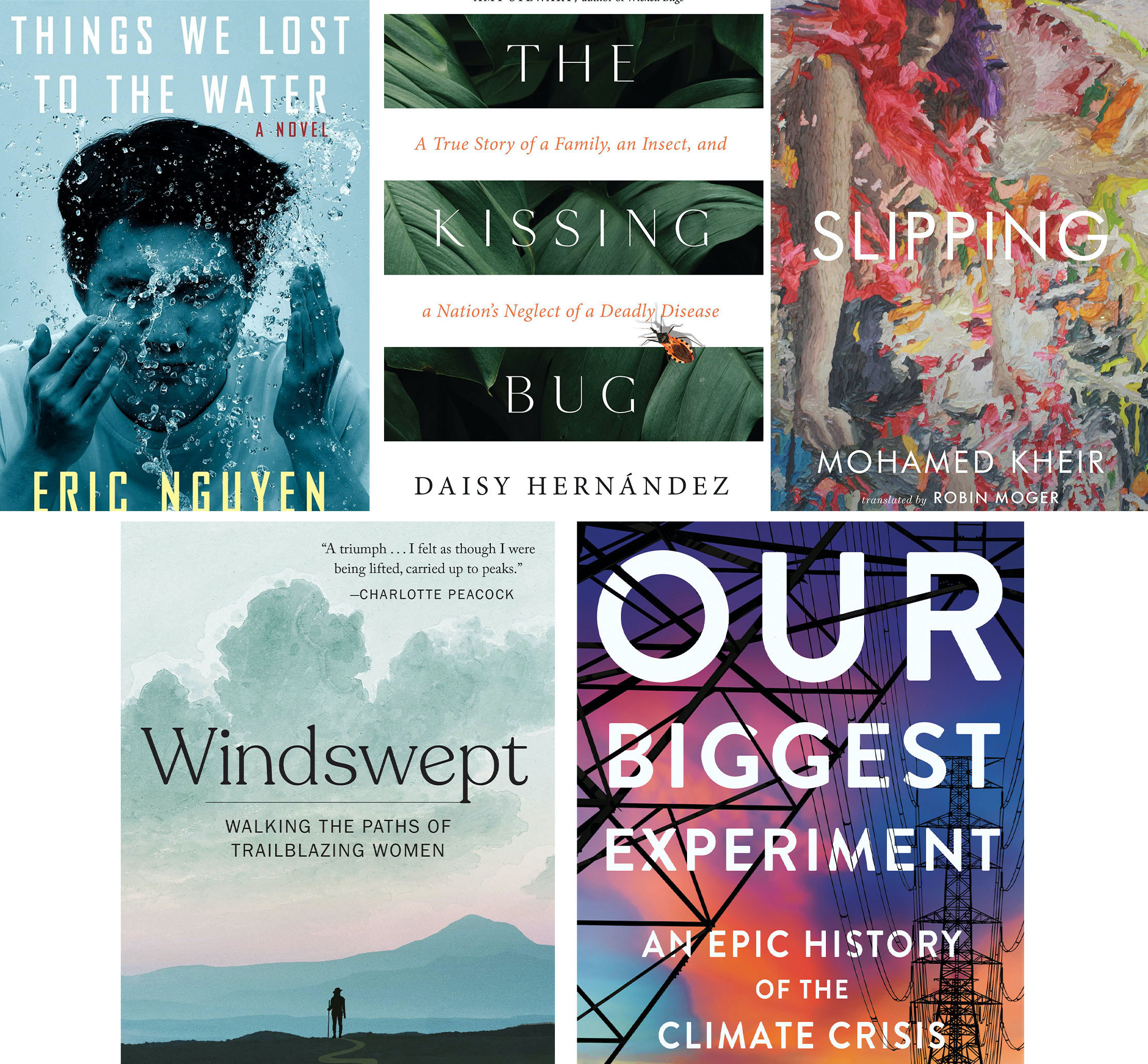As we move deeper into a climate change–affected world, our relationships with the earth are changing. These relationships are varied — micro and macro, obvious and subtle, painful and loving; this planet and our connection to it is nothing if not multifaceted. The following books, new and forthcoming, explore the natural world, reckon with humanity in an environmental context, and chronicle the many aspects of life on earth.

Self-Portrait With Cephalopod by Kathryn Smith (Milkweed Editions, out now)
Cephalopods are a molluscan class of sea creature characterized by, among other things, bilateral symmetry. Kathryn Smith’s poems embrace a kind of lyrical symmetry alongside the fragmentation of loss — loss of ecology, loss of attention, loss of hope. The poems here don’t shy away from a sense of doom, but neither do they succumb to it; they cling to a love that propels us forward, no matter how imperfectly. They are observational and emotional at once, and a welcome addition to the ever-growing canon of art that processes climate change grief.
Get it from Bookshop, Barnes and Noble, or your local library.
Earth’s Wild Music: Celebrating and Defending the Songs of the Natural World by Kathleen Dean Moore (Counterpoint, out now)
The title of Kathleen Dean Moore’s new essay collection speaks for itself. An environmental activist and pianist, Moore renders the natural world through the lens of music, which is everywhere in the natural world. Celebrating, mourning, and defending the songs and voices of creatures from whales to wolves, this book is a grounding and incisive read.
Get it from Bookshop, Barnes and Noble, or your local library.
The Seed Keeper by Diane Wilson (Milkweed Editions, out now)
Diane Wilson knows a lot about seeds. As the executive director of the Native American Food Sovereignty Alliance, she works toward increasing Indigenous food sovereignty and preservation of seeds and traditional plant food varieties. In her debut novel (she previously authored a memoir), Wilson tells a multigenerational story through the eyes of Rosalie Iron Wing, a Dakota woman who discovers her own connection to food, plants, and heritage. It’s a gorgeous and moving work of fiction with memorable characters that will stay in your heart and body for a long time.
Get it from Bookshop, Barnes and Noble, or your local library.
Elemental: Earth Stories edited by Sarah Coolidge (Two Lines Press, out now)
This multinational anthology includes environmental fiction in translation from Japan, Norway, Madagascar, Iran, Germany, Israel, Iraq, and Poland. Each story deftly weaves humanity and its shortcomings with the wild, rocky earth on which we reside— from a family in Japan and its heirloom stones to a political prisoner flying away on the wind. Elemental is a short but powerful anthology, and a must-read collection of a diverse array of writing.
Get it from Bookshop, Barnes and Noble, or your local independent bookstore.
Northern Light: Power, Land, and the Memory of Water by Kazim Ali (Milkweed Editions, out now)
As a queer Muslim person born in London and raised in a series of small towns and cities in Manitoba, Canada, Kazim Ali struggled with a sense of belonging while growing up. In this memoir, Ali chronicles the process of revisiting the land on which he came of age: the Manitoba town of Jenpeg, which sprouted up around a hydroelectric dam in the Nelson River. Returning to this place, he connects with people of the Pimicikamak community and reckons with ideas of power, land, and what it means to occupy, care for, and/or belong to a place.
Get it from Bookshop, Barnes and Noble, or your local library.
The Book of Difficult Fruit: Arguments for the Tart, Tender, and Unruly by Kate Lebo (Farrar, Straus and Giroux; out now)
In this collection from Pie School founder Kate Lebo, each of 26 essays is named after a fruit that symbolizes aspects of Lebo’s life and life in general. Weaving botanical and medicinal histories, relationships between people and land, and the idea of nourishment, this book (which includes recipes) is inventive and charming, but it’s also profound and deeply felt. The connection between food and land is never forgotten, and the writing is superb.
Get it from Bookshop, Target, or your local library.

Things We Lost to the Water by Eric Nguyen (Knopf; May 4)
This debut novel follows a Vietnamese family who flee to New Orleans in 1979. Over 26 years, they weather storms literal and metaphorical, including, of course, one of the most devastating environmental and manmade catastrophes of modern times, Hurricane Katrina. As they learn to be in a relationship with the land and the society built on it, they grow apart and together, culminating in the biggest storm of all.
Get it from Bookshop, Target, or your local library.
The Kissing Bug: A True Story of a Family, an Insect, and a Nation’s Neglect of a Deadly Disease by Daisy Hernández (Tin House; June 1)
The thing about Earth is it has a lot of bugs. And some of those bugs are parasites. Chagas are one such parasite, carried in “kissing bugs,” which are found in Latin America and the US. Daisy Hernández, whose A Cup of Water Under My Bed is one of the great contemporary memoirs, lost her aunt to the “kissing bug disease” in the 1980s. In her thirties, she decided to learn more about this rare illness, and uncovered a whole world of systemic inequities and deliberate policies that keep it hidden from public consciousness. This is a gripping and lyrical work of nonfiction that says a lot about how people, specifically white Western colonizers, interact with the more frightening aspects of nature.
Get it from Bookshop, Barnes and Noble, or your local library.
Slipping by Mohamed Kheir, translated by Robin Moger (Two Lines Press; June 8)
This is the first work of celebrated and prolific Egyptian writer Mohamed Kheir to be translated into English, and despite its brevity, it packs a big punch. The novel follows a struggling journalist named Seif, whose editor introduces him to a strange source with vast knowledge of magical places in Egypt. The two set off to explore these places together, and the (super) natural world they discover spurs Seif into ever more intense reckoning with his past trauma and the loss of his lover, Alya, who could sing in any sound, including waves and wings. Slipping centers the magic of the Earth — the blurred lines between “real” and “unreal” — and the descriptions are stunning.
Get it from Bookshop, Barnes and Noble, or your local library.
Windswept: Walking the Paths of Trailblazing Women by Annabel Abbs (Tin House; Sept. 7)
In this hybrid memoir/analysis, fiction writer and journalist Annabel Abbs reflects on the simple act of walking, in her own life and in the lives of other creative women in history. Among her subjects are Daphne du Maurier and Georgia O’Keeffe, and through studying their relationships with walking along with her own, she connects clarity of mind, communion with land, and rejection of gender roles to this specific corporeal movement — one which many have turned to in the past year.
Get it from Bookshop, Barnes and Noble, or your local independent bookstore.
Our Biggest Experiment: An Epic History of the Climate Crisis by Alice Bell (Counterpoint, 9/21)
This book is a tome, but the climate crisis is nothing if not voluminous. Alice Bell, who runs communications for the climate change organization Possible, is a journalist and academic with a PhD in science communication. This book is very readable for a non-academic, and catalogs the history not only of how the climate crisis got to this point but, crucially, who has shaped our understanding of it. From histories of energy systems to the development of big science, this comprehensive book is an epic feat of storytelling.
Get it from Bookshop, Barnes and Noble, or your local library.
Sarah Neilson is a freelance writer. They can be found on Twitter at @sarahmariewrote.
